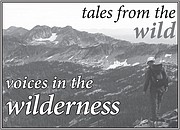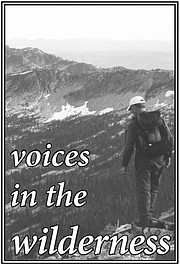Family and fall in the South Fork of Ross Creek
We moved West in the early 1970s because we found it quiet and beautiful, and much less busy than Minneapolis. After some substitute teaching and a summer on the Forest Service trail crew, I was hired as a member of the planning team on the Kootenai National Forest. They were a great bunch, and they recognized that I had no forestry or engineering skills, so I became the team’s ‘environmentalist.’
One of my assignments was to fly around the forest in a little Bell helicopter, sans doors, to video tape and photograph all the unknown blank spots on the engineer’s maps, part of the process called Roadless Area Review and Evaluation (the RARE Studies). The young pilot was fresh out of Vietnam. We did some crazy things, left unrecorded.
I was often a bit high from staring through viewfinders while bouncing over warm ridges, but the memories of those wild spaces are oh, so pleasant and permanent: surprising grizzlies on Roderick Mountain; seeing caribou around Mount Henry (just a probable sighting); tracing the roadless edges of the Ten Lakes area; discovering the folds of the Vermillion River; realizing how narrow and fragile the Cabinet Mountains Wilderness really is.
One place of particular magic was the upper forks of Ross Creek, above the cedars. The alpine basins along the Montana/Idaho divide there demonstrate fancy bedrock and lush alpine vegetation.
North Fork of Ross Creek was so lush that when I hiked it later on my own time, I found myself going hand over hand in a steep tangle of Pacific yew. The climb was worth it, the country wild, and there were mountain goats below us as we looked into Little Spar Lake. The Middle Fork also required effort to explore, but I discovered there was an easier route to the upper South Fork.
The Dry Creek road, rough, but open back then, switchbacked up from the Bull River Highway, gaining most of the elevation through cut over spruce forest. Early one fall during my parent’s annual visit to see the grandkids, I took my dad up there in our ‘53 Willys Overland. We iked to the ridge (his first time under a backpack, I think) and camped near a vantage point looking across the upper South Fork at Sawtooth Mountain.
The day then ending had featured the best of one of those once-predictable Indian summers, heavy with the smell of ripening huckleberries. As we were setting up camp in a miniature meadow, we heard a bugle. And then another. There were three or four bulls down in the South Fork, deep under the hemlock/fir canopy along the bottom. We couldn’t see them, but their cathedral-walled calls rose to us all night.
I think my dad pretty well froze stiff overnight in our light tent, but I got the coffee going in the morning, and we took our first cups out to our little viewpoint. The bugling had slowed down, and sounded less hallowed. The other side of the South Fork was vertically striped with snow slides, yellow and orange-leaved against the timber, like fancy wallpaper on the other side of our room. The elk had moved with the dawn into these openings. The game trails traversing them were hidden from obvious view, but along a couple of these bulls were visible — one of them noticeably bigger than the other — both of them becoming hoarse from the all-night concert.
We watched for a long time, through a second cup of coffee, with morning sun warming our backs and lighting their flanks as they trotted back and forth meeting challenges. My dad is gone, but I can call up those sights and sounds right now, on command. Best part of this story? A bunch of people back then decided that those West Cabinet basins and flanks were special, and all those bugles important, so they became a voice for the Scotchman’s Peak Wilderness. Now you will find that country every bit as pristine, because their zeal is alive and well. But you’ll need to walk further to see those elk. The Dry Creek road washed out long ago.
Lance Shevlan worked on the Kootenai National Forest from the 70s to the 80s. This column is provided by Friends of Scotchman Peaks Wilderness.





